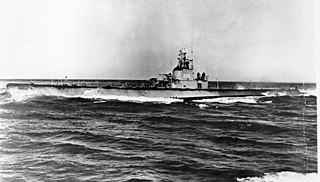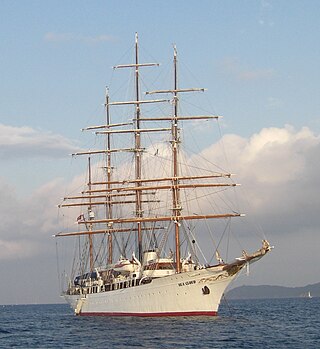
The first USS Newark (C-1) was a United States Navy protected cruiser, the eighth protected cruiser launched by the United States. In design, she succeeded the "ABC" cruisers Atlanta, Boston, and Chicago with better protection, higher speed, and a uniform 6-inch gun armament. Four additional protected cruisers were launched for the USN prior to Newark.

USS Fairfax (DD-93) was a Wickes-class destroyer in the United States Navy during World War I, later transferred for World War II service first to the Royal Navy as HMS Richmond (G88), a Town-class destroyer, and then to the Soviet Navy as Zhivuchy.
The names of commissioned ships of the United States Navy all start with USS, for United States Ship. Non-commissioned, primarily civilian-crewed vessels of the U.S. Navy under the Military Sealift Command have names that begin with USNS, standing for United States Naval Ship. A letter-based hull classification symbol is used to designate a vessel's type. The names of ships are selected by the Secretary of the Navy. The names are those of states, cities, towns, important persons, important locations, famous battles, fish, and ideals. Usually, different types of ships have names originated from different types of sources.

USS Onyx (PYc-5), was a diesel coastal patrol yacht of the United States Navy during World War II.

USS Cobia (SS/AGSS-245) is a Gato-class submarine, formerly of the United States Navy, named for the cobia.

USS Mayflower (PY-1) was a 275 ft (84 m), 2,690 t (2,650 LT) motor vessel originally built as a private yacht that went on to serve in a variety of military, governmental, and commercial roles.

USS Williamsburg was a US Navy gunboat. A former private yacht, it also served as a presidential yacht from 1945 to 1953.
USS Adamant (AMc-62) was an Accentor-class minesweeper in the United States Navy during World War II.

USS Daniel (DE-335) was an Edsall-class destroyer escort in service with the United States Navy from 1944 to 1946. She was scrapped in 1974.
USS Bold (AMc-67) was an Accentor-class minesweeper laid down on 27 August 1941 at South Bristol, Maine, by the Bristol Yacht Building Co.; launched on 2 April 1942; sponsored by Miss Ella E. Gamage; delivered to the U.S. Navy on 18 May 1942; fitted out at the Boston Navy Yard; and placed in service there on 27 May 1942.

Lanikai, was a wooden hulled schooner-rigged diesel powered yacht in service with the United States Navy during both World War I and World War II, before being transferred to the Royal Australian Navy.

USS Arctic (AF-7) was an Arctic-class stores ship acquired by the United States Navy shortly after World War I, which saw extensive service in World War II. She served in the Pacific Ocean, delivering food and household items to ships and bases.
USS Assertive (AMc-65) was an Accentor-class coastal minesweeper acquired by the U.S. Navy for the dangerous task of removing mines from minefields laid in the water to prevent ships from passing.

USS Brambling (AMS-42/YMS-109) was a YMS-1-class auxiliary motor minesweeper acquired by the U.S. Navy for the task of removing mines from water that had been placed there to prevent ships from passing.
USS Vamarie (IX-47) was a ketch-rigged ocean racing yacht designed by Jasper Morgan of Cox & Stevens, Inc., and built in 1933 at Bremen, Germany, by Abeking and Rasmussen, for S. Vadim Makaroff of Oyster Bay, Long Island.

USS Mizpah (PY-29) was a United States Navy patrol yacht. Constructed in 1926, the vessel was constructed as the pleasure yacht Savarona. In 1929 it was renamed Allegro and then Mizpah for use on the Great Lakes. The vessel was acquired by the United States Navy in 1942 and converted to a warship and commissioned the same year. Mizpah served as a convoy escort along the United States East Coast before becoming a school ship in 1944. Following the end of the war, the vessel returned to private operation in 1946 until 1967 when Mizpah was laid up with a broken crankshaft at Tampa, Florida. An attempt to save the ship proved futile and Mizpah was scuttled off the coast of Florida as an artificial reef in 1968. The wreck is now a popular dive site.

The third USS Wanderer (SP-132), was an armed yacht that served in the United States Navy from 1917 to 1919.

Sea Cloud is a sailing cruise ship owned by Sea Cloud Cruises of Hamburg, Germany. Launched as a private yacht as Hussar V for Marjorie Merriweather Post in 1931, she later served as a weather ship for the United States Coast Guard and United States Navy during World War II, when she became the U.S. military's first racially integrated warship since the American Civil War. After the war, Sea Cloud was returned to private ownership, serving as a yacht for numerous people, including as presidential yacht of the Dominican Republic. Since 1979, Sea Cloud has been used as a cruise ship.

The USS Alabaster (PYc-21) was a coastal patrol yacht of the United States Navy during World War II.

Lyndonia, built 1920, was the second steam-yacht bearing the name and the third yacht built for publisher Cyrus H.K. Curtis of the Curtis Publishing Company by the then Consolidated Shipbuilding Company of Morris Heights, New York. The name is taken from the historic name of his estate, Lyndon, in Wyncote, Pennsylvania.














